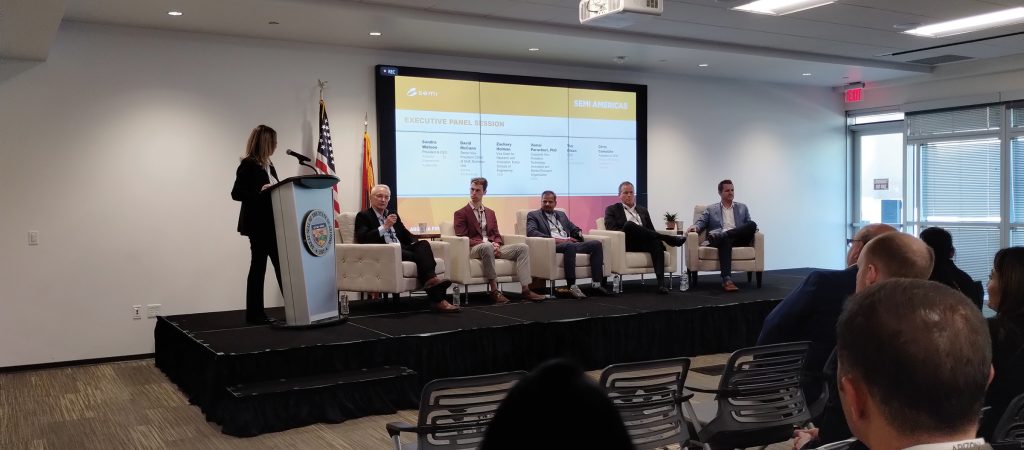 Elected officials and semiconductor industry leaders gathered in April at Arizona Commerce Authority’s Semi Breakfast Fueling Innovation: How Arizona is leading the charge in next generation semiconductor development, a forum hosted by the ACA to discuss the importance of semiconductor development in building a resilient Arizona economy.
Elected officials and semiconductor industry leaders gathered in April at Arizona Commerce Authority’s Semi Breakfast Fueling Innovation: How Arizona is leading the charge in next generation semiconductor development, a forum hosted by the ACA to discuss the importance of semiconductor development in building a resilient Arizona economy.
The message was clear: Semiconductor growth is a top economic priority and is gaining momentum thanks to close collaboration among businesses, academia and government. All working toward shared goals for the industry’s future in Arizona.
“With more and more chips coming off the line, I’m constantly reminded of the amazing things that are taking place and the limitless opportunities to come,” said Arizona Gov. Katie Hobbs at the breakfast. “These opportunities will be center stage at SEMICON West in Phoenix this October, and there’s no other state that brings together industry, education, workforce development and government like we do to support the entire semiconductor ecosystem.”
Phoenix Mayor Kate Gallego echoed a similar message: Semiconductors are shaping the future of Arizona. Since 2020, Arizona has led the nation in new semiconductor investments, with more than 50 industry expansions representing more than $205 billion in investment and roughly 25,000 new jobs, according to Hobbs.
These expansions span the full supply chain from manufacturing and advanced packaging to research and development. In October, Phoenix will host SEMICON West for the first time, a major U.S. semiconductor conference that brings global microelectronics leaders to the Valley and further positions the city as a hub for innovation and growth.
In January, Arizona was selected as the site of one of three flagship CHIPS for America research and development facilities. The co-located National Semiconductor Technology Center’s prototyping and advanced packaging facility will be based at Arizona State University’s Research Park in Tempe. It marks Arizona’s first national lab and will focus on 300mm front-end and packaging R&D. Beyond R&D, Arizona is becoming a center of semiconductor manufacturing. In April 2025 alone, several leading tech companies announced projects totaling more than $100 billion in planned investment. Taiwan Semiconductor Manufacturing Co. broke ground on its third fab in Phoenix, expected to create 6,000 jobs and manufacture two-nanometer and more advanced chips. Amkor Technology is building a $2-billion packaging facility in Peoria, located near TSMC, to address domestic supply chain gaps.
These investments are being driven by surging demand for artificial intelligence and the growing need for data center infrastructure.
While Arizona is quickly taking center stage for semiconductor development, critical infrastructure gaps remain, particularly labor force voids. Several speakers at the event pointed to the shortage of technician-level talent as a significant hurdle to continued growth. David McCann, senior VP and chief of staff at Amkor Technology, emphasized that building the workforce is a collaborative effort with high school students on a pathway to community college representing a critical entry point for technician training and hiring.
Following a $407-million federal award to help build its new advanced packaging and test facility in Peoria, Amkor announced it will invest at least $10 million locally over the next six years. The funding will support workforce development, transportation, K-12 curriculum and a partnership with the Peoria Unified School District focused on STEM programs in semiconductor and microelectronics.
Deirdre Hanford, CEO of Natcast, a nonprofit that operates the NSTC by the Department of Commerce, said approximately 67,000 semiconductor jobs could go unfilled nationwide by 2030. To help address that gap, Natcast is giving a $1.7-million grant to Maricopa Community Colleges to create a two-year program comprised of a two-week “quick start” program and a six-week program along with paid internships to support talent incubation.
Greater Phoenix Economic Council’s President and CEO Chris Camacho added that reskilling the labor force is critical to ensuring the nation’s success in semiconductor manufacturing.
“The talent base, on an engineering front, will be a big issue, and the technician aspect of the country is extraordinarily underserved,” said Camacho. “We’ll need to commit to not only building more for-profit and community college infrastructure but getting into high schools to expose parents and students to the future of this industry, which is a new emerging sector that provides incredible jobs and benefits.”
According to Camacho, the winning formula for setting Arizona up for the semiconductor boom won’t develop overnight. It takes a multi-decade approach and a dedicated vision. All the utilities, industry partners, cities and academia must come together to build an ecosystem without gaps, which requires a solid foundation and future planning focused on building Arizona’s infrastructure, workforce, and research and development.
Concerns for Arizona’s Semiconductor Industry Success
- Maintaining water supply
- Building a skilled workforce
- Navigating federal and state policy uncertainty
- Sourcing power for the AI demand (data centers)
Did You Know: Since 2020, Arizona has led the nation in new semiconductor investments, welcoming more than 50 expansions in the semiconductor industry, representing more than $205 billion in investment and roughly 25,000 new jobs.














